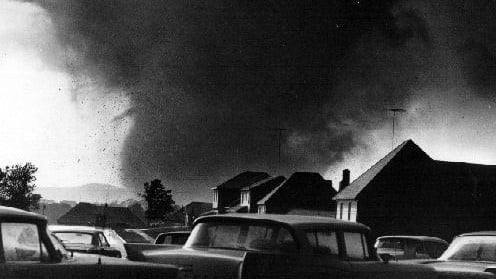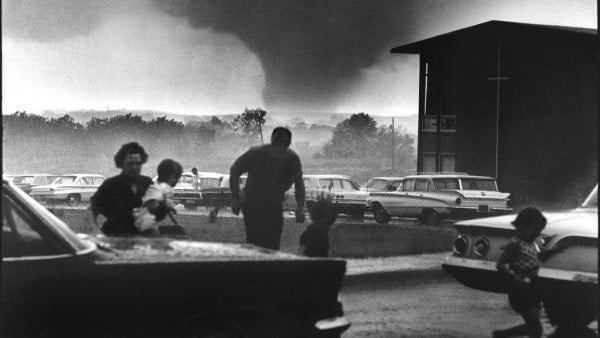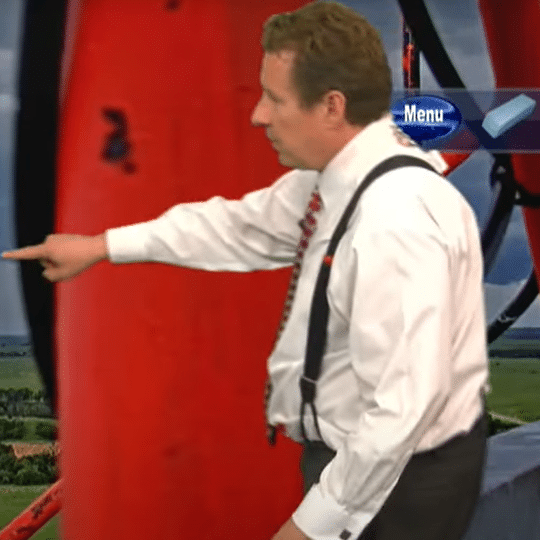
On June 8, 1966, Topeka was struck by one of the most devastating tornadoes in U.S. history, a monstrous F5 that tore through the heart of the city, leaving a path of destruction still talked about generations later. With winds exceeding 250 miles per hour, the tornado carved a swath nearly half a mile wide and 22 miles long, causing catastrophic damage. It’s a day that lives on in the memories of those who experienced it, and a day that makes us wish we had someone like Chief Meteorologist Jeremy Goodwin — and his signature suspenders — around to give us the warning.
The Day Topeka Stood Still
The 1966 tornado brought Topeka to its knees, flattening entire neighborhoods, demolishing landmarks like the Washburn University campus, and turning residential areas into fields of debris. Thirty minutes of fury left 16 people dead, hundreds injured, and an estimated $100 million in damages (over $900 million in today’s dollars). The event remains one of Kansas’s most destructive natural disasters.

Today, with meteorologists like Jeremy Goodwin on our screens, we’re more fortunate than ever to receive early warnings and expert guidance. Back then, however, forecasting technology was rudimentary at best. Many residents had little warning before the tornado touched down, making it a day marked by both tragedy and acts of incredible bravery.
Jeremy Goodwin: The Weatherman Topeka Needs (and Deserves)
Imagine if Jeremy Goodwin, WIBW’s chief meteorologist, had been around in 1966. Picture him in his suspenders, calmly delivering real-time updates with that signature mix of professionalism and down-to-earth humor. He’d probably remind us to grab more than just a flashlight and keep those family photos safe — all while making us feel, somehow, that everything was going to be all right.

Today, Topeka relies on Goodwin for accurate forecasts, whether it’s severe weather or that all-important Halloween forecast. And in a place as tornado-prone as Kansas, we’re grateful for his steady presence in the face of unpredictable weather. The “Strong Tornadoes” alert he recently shared for northeast Kansas is exactly the type of timely, informative update that people in 1966 would have benefited from.
Advances in Technology and the Goodwin Factor
Weather forecasting has come a long way since the 1960s. Today’s meteorologists have access to Doppler radar, satellite imagery, and cutting-edge technology that lets them track storms with unprecedented accuracy. Yet, the heart of local weather reporting remains that connection between a weatherman and his community. Jeremy Goodwin embodies that in Topeka, offering expertise, accessibility, and a touch of humor that keeps people informed and reassured.

Goodwin’s suspenders have become a bit of a legend around here, a symbol of trust for anyone watching WIBW’s forecasts. It’s fun to imagine him tracking that historic 1966 tornado, urging Topekans to “take cover” with the same no-nonsense approach he uses today.
Looking Back with Gratitude and Looking Forward with Preparedness
The 1966 tornado reshaped Topeka both physically and emotionally, leaving scars on the city that are still visible today. But it also united the community, reminding us of the resilience and strength that define Kansans. As we face future storms, we can’t help but feel a little luckier knowing we have meteorologists like Jeremy Goodwin on our side. So here’s to Jeremy — and his suspenders. If there’s ever another day like June 8, 1966, we’re grateful to know that he’ll be here, helping us all stay one step ahead of whatever Mother Nature has in store.




